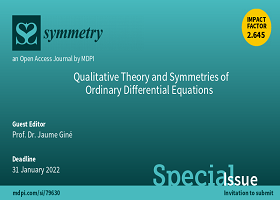Qualitative Theory and Symmetries of Ordinary Differential Equations
A special issue of Symmetry (ISSN 2073-8994). This special issue belongs to the section "Mathematics".
Deadline for manuscript submissions: closed (31 January 2022) | Viewed by 8940

Special Issue Editor
Special Issue Information
Dear Colleagues,
Qualitative analysis has proved to be an important and useful tool for investigating the properties of solutions of differential equations, because it is able to analyze differential equations without solving them analytically and numerically. Since the qualitative analysis of differential equations is related to both pure and applied mathematics, its applications to various fields such as science, engineering, and ecology have been extensively developed.
The objective of this Special Issue is to report on the latest achievements in the qualitative theory of ordinary differential equations and their relation to the symmetries of differential equations. It will reflect both the state-of-the-art theoretical research and important recent advances in applications. It is important to develop new theories and methods, as well as to modify and refine the well-known techniques for the analysis of new classes of problems using the symmetries of differential equations. We are mainly interested in ordinary differential equations, autonomous or non-autonomous, smooth or non-smooth. We hope to gather together established and young scientists actively working on the subject.
This Special Issue will collect high-quality contributions from leading experts and researchers actively working in the field. The topics of interest include, but are not limited to the singularities and local behavior of solutions, the stability properties and asymptotic behavior of solutions, existence, the bifurcations and stability of periodic solutions, the existence and properties of almost-periodic solutions, nonlinear ordinary differential operators, and the symmetries and integrability of ordinary differential equations.
Prof. Dr. Jaume Giné
Guest Editor
Manuscript Submission Information
Manuscripts should be submitted online at www.mdpi.com by registering and logging in to this website. Once you are registered, click here to go to the submission form. Manuscripts can be submitted until the deadline. All submissions that pass pre-check are peer-reviewed. Accepted papers will be published continuously in the journal (as soon as accepted) and will be listed together on the special issue website. Research articles, review articles as well as short communications are invited. For planned papers, a title and short abstract (about 100 words) can be sent to the Editorial Office for announcement on this website.
Submitted manuscripts should not have been published previously, nor be under consideration for publication elsewhere (except conference proceedings papers). All manuscripts are thoroughly refereed through a single-blind peer-review process. A guide for authors and other relevant information for submission of manuscripts is available on the Instructions for Authors page. Symmetry is an international peer-reviewed open access monthly journal published by MDPI.
Please visit the Instructions for Authors page before submitting a manuscript. The Article Processing Charge (APC) for publication in this open access journal is 2400 CHF (Swiss Francs). Submitted papers should be well formatted and use good English. Authors may use MDPI's English editing service prior to publication or during author revisions.
Keywords
- qualitative theory
- stability
- bifurcation
- singular points
- periodic solutions
- symmetries
- integrability





